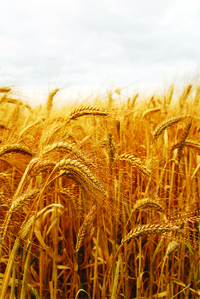
A Fragile Market: When grain is burned, less is left behind
Jim Knisley
Features Business & Policy Farm BusinessWhen grain is burned, less is left behind
One of the most decisive moments for commodity prices over the next 20
months is now. Farmers across North America are deciding what they will
plant this spring and harvest next fall.
 |
| What to Plant? As ethanol and biofuel policies push forward, livestock producers face increased feed costs and consumers higher grocery bills. |
One of the most decisive moments for commodity prices over the next 20 months is now. Farmers across North America are deciding what they will plant this spring and harvest next fall.
Last year tens of millions of acres shifted from soybeans to corn. The result was corn prices, which had surged through the previous six months, fell back and soybean prices took off. Wheat, which had long been a doormat, attracted little attention. But a dry summer on the Canadian Prairies and the U.S. plains and a continuing drought in Australia changed that in a hurry. As winter set in wheat prices bounced to record levels.
This winter wherever grain and oilseed producers look they are seeing prices that would have been unimaginable just two years ago.
They are also facing fertilizer and fuel prices higher than their worst
fears.
While weather, a growing worldwide population and increased prosperity in India and China contributed to tight grain and oilseed supplies many analysts and observers see booming grain ethanol as the tipping agent.
“The ethanol craze could not have come at a worse time. There would have been tight supplies of grains and oilseeds anyway, but turning 25 per cent of the (near-record) U.S. corn crop into ethanol was the most misguided alcohol policy since Prohibition,” Donald Cox, Global Portfolio Strategist for the BMO Financial Group, says in his market newsletter Basic Points.

The grain and oilseed supply situation is remarkably fragile. Low grain inventories – and near record low stocks-to-use ratios – have set the stage for manic price swings. Just how fragile the markets are can be demonstrated by what happened with wheat this year.
The USDA estimates world wheat production this year at 600.5 million tonnes, down 5.8 million tonnes from 2006 with the Australian drought the main culprit. Total wheat production fell by less than one per cent. But prices reacted with a vengeance.
“It is a measure of how slender is the global grain surplus that a one per cent production drop (wheat) doubles the price,” Cox writes.
It is also a measure of what economists call elasticity. They have long recognized that agricultural products are notoriously inelastic and that comparatively small increases in demand or reductions in available supplies will cause a dramatic change in price.
The reason is simple – people must eat. If costs rise they have little choice but to pay, keeping per capita demand stable. But if the cost of food falls they may change what they eat, but they won’t eat much more. You can’t in effect “cram it down their throats.”
In 1972/73 there was the textbook example of how grain markets and grain prices respond to a sudden surge in demand.
In 1972, the United States, Canada and other grain exporters were wrestling with chronic surpluses. In mid-1972 the Soviet Union started quietly contacting grain companies. They signed large, but not overwhelming contracts with each of them, as well as with the Canadian Wheat Board, for deliveries of wheat and soybeans for early 1973.
All of the U.S. contracts were signed at the government-regulated export price of $1.63 a bushel.
When what was called the Great Grain Robbery ended, the Russians had arranged for delivery of more than 24 million tonnes of wheat and feed grains.
The impact was stunning. World grain stocks fell by 40 million tonnes in a little more than a year, corn stocks were down a third and wheat stocks fell 75 per cent.
The response came quickly. Corn, wheat and soybean prices surged and consumer prices jumped with double-digit retail increases for eggs, poultry, beef and somewhat later, pork.
In his classic study of the era Merchants of Grain, Dan Morgan writes: “It (government) was remembering the basic truth: When grain is exported less is left behind.”
Today it is becoming clearer that an amended version of that “basic truth” applies: “When grain is burned less is left behind.”
The Wall Street Journal in a front-page report in December said: “In the span of one growing season, ethanol has gone from panacea to pariah in the eyes of some.”
Grain stocks worldwide are expected to fall to their lowest level in 35 years in 2008, raising concerns that economies will be hit by soaring prices.
The Korea Rural Economic Institute reported recently that the lowest level of world grain stocks in more than three decades points to higher prices next year.
“The problem we are having is that the world can’t meet the surging demand due to a supply shortage,” said Sung Myung-hwan, a senior researcher at the institute.
While China, India and developing countries are responsible for some of the increased demand so is the government-subsidized surge in ethanol. The amount of corn turned into ethanol rose by about 40 million tonnes in the U.S. alone over the past two years and is expected to rise again in 2008 when up to 50 more refineries come on line.
On a proportional basis this is very similar to what happened during the Great Grain Robbery.
Meanwhile a recent study by the Organization for Economic Cooperation and Development concluded that biofuels “offer a cure (for oil dependence) that is worse than the disease.”
The study by Richard Doornbosch and Ronald Steenblik says “Biofuels have been championed as an energy source that can increase security of supply, reduce vehicle emissions and provide a new income stream for farmers.”
The study then scrutinizes the assertions.
Technology may allow ethanol and biodiesel to fill 11 per cent of total demand for liquid fuels in the transport sector by 2050, the report said. But realistically it will be less because fuel, feed and food will fight for supplies.
“Any diversion of land from food or feed production to production of energy biomass will influence food prices from the start, as both compete for the same inputs. The effects on farm commodity prices can already be seen today. The rapid growth of the biofuels industry is likely to keep these prices high and rising.
“The conclusion must be that the potential of the current technologies of choice — ethanol and biodiesel — to deliver a major contribution to the energy demands of the transport sector without compromising food prices and the environment is very limited.”
On the environmental front: “Biofuels have a more positive record in respect of their end-of-pipe emissions, but those made from grains and oilseeds are generally more damaging to the environment up-stream.”
A National Academy of Sciences study that said corn-based ethanol could strain water supplies.
A study coauthored by Nobel-prize-winning chemist Paul Crutzen said corn ethanol might exacerbate climate change as the added fertilizer used to grow corn raised emissions of a very potent greenhouse gas called nitrous oxide.
The government of Quebec, which had offered loan guarantees for corn ethanol plants, recently decided not to initiate any new ones. It concluded, “the environmental costs of corn ethanol are higher than expected.”
China has also suspended the development of new corn ethanol refineries.
The OECD report says: “The cost of obtaining a unit of CO2-equivalent reduction through subsidies to biofuels is extremely high, well over $500 per tonne of CO2-equivalent avoided for corn-based ethanol in the United States, for example, with other researched countries not performing much better.”
It would be less expensive and result in greater reductions in GHG’s (greenhouse gases) if governments encouraged more fuel-efficient vehicles and convinced people to walk and bicycle more.
As for the economic benefits to farmers the calculation is straightforward – grain producers win and grain users (especially feed grain users) lose – at least in the short term. Consumers and taxpayers lose both in the short and long term.
The OECD report says that ethanol is an industry that was created by ill-conceived government subsidies and comes with very high costs and very little (if any) benefit.
“Governments should cease creating new mandates for biofuels and investigate ways to phase them out,” the report concludes.
On the food front prices at the consumer level in Canada and the U.S. are up, but not yet dramatically.
The U.S. Producer Price Index shows that crude food is up 26.3 per cent, intermediate foods and feed is up 16.9 per cent and finished consumer foods are up 6.7 per cent.
Outside of North America and Europe the situation is shaping up to be quite different.
Jacques Diof, head of the United Nations Food and Agriculture Organization, said in December that in an “unforeseen and unprecedented” change the world food
supply is dwindling rapidly and prices rising.
There is a “very serious risk that fewer people will be able to get food,” he said.
The agency said wheat stocks are down 11 per cent to the lowest level since 1980 and represent enough to supply 12 weeks of worldwide consumption. The average from 2000 to 2005 was 18 weeks supply.
“We’re concerned that we are facing the perfect storm for the world’s hungry,” Josette Sheeran, executive director of the World Food Program, told the New York Times.
The aid agency’s cost of acquiring food had gone up 50 per cent in the past five years and some of the poor “were being priced out of the food market.”
On commodity markets hard, bread making, wheat prices have been hovering around the $10 a bushel level while durum, used to make pasta, has been running more than 10 per cent higher.
As 2007 ended soybeans were over $12 a bushel, corn was more than $4.50 a bushel, canola (in store Vancouver) more than $500 a tonne and feed barley more than $200 a tonne.
Late in 2007, the U.S. Congress passed legislation calling for a further doubling of grain ethanol production by 2015. It also called for the production of 21 million gallons a year of ethanol or other biofuels from cellulose biomass. The technology to do that economically on a commercial scale is still being developed.
Meanwhile back on the farm producers are trying to figure out what to grow.
Corn demand will remain strong, prices are good, but fertilizer and fuel prices are way up. Soybean prices are also up and the crop requires little or no fertilizer. Wheat is pretty easy to produce, input costs are less than corn and prices are stronger than ever, but whether it is worth shifting from canola is a good question.
Whatever decisions are made they will be felt by everyone throughout the food, and now, fuel, chain.
Print this page